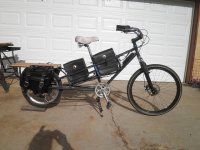toledobythesea
100 µW
- Joined
- Sep 7, 2016
- Messages
- 7
While trying to decide whether to replace a no-name motor that looks to be a 250w having a reduction ratio I calculate to be 3.84:1, I read about larger motors such as Ezee as well as mid-drive motors. This number is important to me as I am in such poor physical shape that pedalling even half a kilometer up a small 3% grade risks me blowing a heart valve or brain artery. Although I haven't measured my own pedal power, I doubt whether I could produce more that 50 watts for more than a minute or so.
Various websites seem to tout mid-drives as superior for hill-climbing. Although I don't remember seeing the reduction ratio quoted for any mid-drives, some photos of their insides suggest to me that their ratios are probably around 5:1 or even 5.5:1. Now the 500w Ezee is advertised as having a 5:1 ratio and I guessed that the Mac and 8Fun hub motors are similar. However, it seems to me that pretty much every outer chainring-rear sprocket combination is what automotive people call overdrive, which will reduce a mid-drive motor's reduction ratio, which will reduce the motor's torque advantage. Whereas the geared hub motor has its nominal torque advantage regardless of chainring/sprocket size. The mid-drive advantage therefore seems to be higher top speeds at the expense of slightly less torque. Have I got this right?
Secondly, can anybody quote exact reduction ratios for the various mid-drives?
The reason I ask along these lines is that for me and I think some other fairly elderly people, top speed isn't what matters, nor long-range either. For me my two cheap no-name bikes are utilities, for carrying as much as thirty pounds of groceries for 3 or 4 klics. I just want to get up the hill! I've measured some of my routes fairly carefully and they all include segments that exceed a 9.6% grade for at least 0.3 kms (which caused phase wire insulation melt on one bike) and there are a couple of routes that have segments ranging between 8.4% and 13.4% for a full kilometer that I would use if I had enough motor boost.
Some kids around here have 1000w+ mid-drives and I was very impressed after riding one without pedalling at all. However I always pedal except when braking - which I do a lot of (being on the lower reaches of a 4000' mountain, my routes are all downhill going out and uphill coming home). Pedalling might help might blood circulation a bit and it certainly keeps me warmer in the winter. I think there are plenty of seniors like me who compare a bike not to a car but to walking. Five times walking speed on the flat is fine by me and two times walking speed uphill beats the alternative of walking my loads uphill.
Various websites seem to tout mid-drives as superior for hill-climbing. Although I don't remember seeing the reduction ratio quoted for any mid-drives, some photos of their insides suggest to me that their ratios are probably around 5:1 or even 5.5:1. Now the 500w Ezee is advertised as having a 5:1 ratio and I guessed that the Mac and 8Fun hub motors are similar. However, it seems to me that pretty much every outer chainring-rear sprocket combination is what automotive people call overdrive, which will reduce a mid-drive motor's reduction ratio, which will reduce the motor's torque advantage. Whereas the geared hub motor has its nominal torque advantage regardless of chainring/sprocket size. The mid-drive advantage therefore seems to be higher top speeds at the expense of slightly less torque. Have I got this right?
Secondly, can anybody quote exact reduction ratios for the various mid-drives?
The reason I ask along these lines is that for me and I think some other fairly elderly people, top speed isn't what matters, nor long-range either. For me my two cheap no-name bikes are utilities, for carrying as much as thirty pounds of groceries for 3 or 4 klics. I just want to get up the hill! I've measured some of my routes fairly carefully and they all include segments that exceed a 9.6% grade for at least 0.3 kms (which caused phase wire insulation melt on one bike) and there are a couple of routes that have segments ranging between 8.4% and 13.4% for a full kilometer that I would use if I had enough motor boost.
Some kids around here have 1000w+ mid-drives and I was very impressed after riding one without pedalling at all. However I always pedal except when braking - which I do a lot of (being on the lower reaches of a 4000' mountain, my routes are all downhill going out and uphill coming home). Pedalling might help might blood circulation a bit and it certainly keeps me warmer in the winter. I think there are plenty of seniors like me who compare a bike not to a car but to walking. Five times walking speed on the flat is fine by me and two times walking speed uphill beats the alternative of walking my loads uphill.



